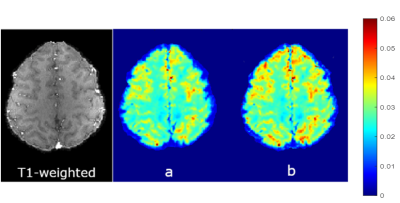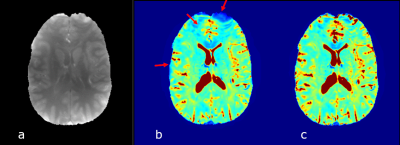seyedeh nasim adnani1, Thomas Denney Jr.1, Alexander Sukstansky2, Dmitriy Yablonskiy2, and adil bashir1
1electrical and computer engineering, auburn university, auburn, AL, United States, 2radiology, Washington university school of medicine in St. Louis, St. Louis, MO, United States
1electrical and computer engineering, auburn university, auburn, AL, United States, 2radiology, Washington university school of medicine in St. Louis, St. Louis, MO, United States
Ultra high-field imaging scenarios suffer from
increased field inhomogeneities compared with 3T scanners or below. Voxel
Spread Function addresses this issue and is feasible for ultra high-field MRI
imaging and compensates for the decreased T2* that is the outcome of the
inhomogeneities.

Representative T1 weighted image and T2* maps from
the in vivo experiment, a) before correction and b) after macroscopic field
inhomogeneity correction. Average increase in the T2* values in both GM and WM
is evident. GM/WM T2* contrast is also increased.

Proton density (a) and examples of T2* maps
calculated without (b) and with F-term correction (c). Regions substantially affected by the B0
field inhomogeneity are indicated by red arrows. F-function correction
significantly reduces magnetic field inhomogeneity artifacts on T2* maps and
sharpens T2* contrast in gray and white matter.
